Queen Nefertiti Drawing Full Body

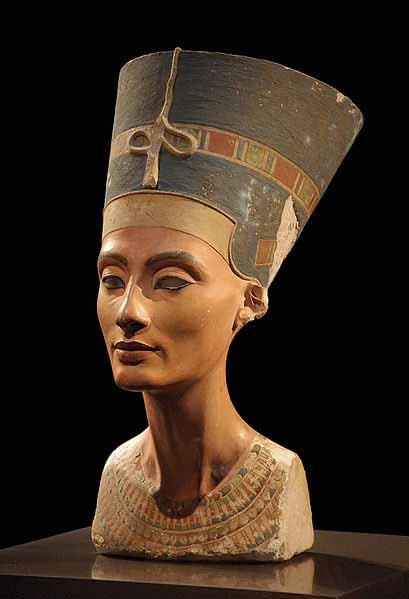
Nefertiti (ca. 1370 BC - ca. 1330 BC) was the Neat Imperial Wife (chief consort) of the Egyptian Pharaoh Akhenaten. Their story is best read on his file. Nefertiti and her husband were known for a religious revolution, in which they worshiped one god but, Aten, or the sun disc.
The verbal dates of when Nefertiti was married to Akhenaten and later promoted to his Queen are uncertain. Yet, the couple had half dozen known daughters.
Her name roughly translates to "the cute one is come". She also shares her name with a type of elongated gold dewdrop that she was often portrayed as wearing, known as "nefer" beads. Famed throughout the ancient world for her outstanding beauty, Nefertiti remains the ane of the most well known Queen of Egypt. Though Akhenaten had several wives, Queen Nefertiti was his principal wife.
She was made famous by her painted limestone bust pictured above, at present in Berlin's Egyptian Museum, shown to the correct. The bust, seen from 2 dissimilar angles, is indeed, the about famous depiction of Queen Nefertiti. Found in the workshop of the famed sculptor Thutmose, the bust is believed to be a sculptor's model. The technique which begins with a carved slice of limestone, requires the stone core to be first plastered and then richly painted. Flesh tones on the confront requite the bosom life.
Her full lips are enhanced by a bold red. Although the crystal inlay is missing from her left middle, both eyelids and brows are outlined in black. Her graceful elongated neck balances the tall, flat-top crown which adorns her sleek head. The vibrant colors of the her necklace and crown contrast the yellow-brown of her polish skin. While everything is sculpted to perfection, the i flaw of the piece is a broken left ear. Considering this remarkable sculpture is still in beingness, information technology is no wonder why Nefertiti remains 'The Most Beautiful Woman in the World.'
Long-Hidden 3D Browse of Aboriginal Egyptian Nefertiti Bust Finally Revealed Live Science - November 25, 2019
In Berlin, the state-funded Egyptian Museum and Papyrus Collection has a loftier-quality, full-color 3D scan of the most iconic portrait sculpture ever produced, the 3,364-year-old Bust of Nefertiti. Information technology has held this artifact since 1920, just a few years after its discovery in Amarna, Egypt; Arab republic of egypt has been demanding its repatriation e'er since it first went on display. The bust is one of the about copied works of ancient Egyptian art, and has become a cultural symbol of Berlin. For reasons the museum has difficulty explaining, this scan too is off-limits to the public.Rather, it was off-limits. I was able to obtain it afterwards a three-year-long freedom of information endeavor directed at the system that oversees the museum. Read more
Nefertiti'southward origins are confusing. It has been suggested to me that Tiye was likewise her mother. Some other suggestion is that Nefertiti was Akhenaten's cousin. Her wet nurse was the wife of the vizier Ay, who could accept been Tiy'southward brother. Ay sometimes called himself "the God's male parent," suggesting that he might have been Akhenaten'south father-in-law. Nonetheless Ay never specifically refers to himself every bit the father of Nefertiti, although there are references that Nefertiti's sister, Mutnojme, is featured prominently in the decorations of the tomb of Ay. We may never know the truth of this bloodline.
Life
Nefertiti commencement appears in scenes in Thebes. In the damaged tomb (TT188) of the imperial butler Parennefer the new king Amenhotep 4 is accompanied by a majestic adult female, and this lady is thought to be an early depiction of Nefertiti. The king and queen are shown worshiping the Aten. In the tomb of the vizier Ramose Nefertiti is shown standing behind Amenhotep IV in the Window of Appearance during the advantage ceremony for the vizier.
During the early years in Thebes Akhenaten (still known as Amenhotep 4) had several temples erected at Karnak. I of the structures, the Mansion of the Benben (hwt-ben-ben), was dedicated to Nefertiti. She is depicted with her daughter Meritaten and in some scenes the princess Meketaten participates in the scenes besides. In scenes found on the talatat Nefertiti appears nearly twice every bit often as her husband. She is shown actualization behind her husband the Pharaoh in offer scenes in the office of the queen supporting her husband, merely she is also depicted in scenes that would accept normally been the prerogative of the king. She is shown smiting the enemy, and captive enemies decorate her throne.
In the fourth year of his reign Amenhotep Iv decided to motion the majuscule to Akhetaten (modern Amarna). In his fifth year, Amenhotep Four officially inverse his proper name to Akhenaten, and Nefertiti was henceforth known as Neferneferuaten-Nefertiti. The proper noun change was a sign of the ever-increasing importance of the cult of the Aten. Information technology inverse Arab republic of egypt's religion from a polytheistic religion to a organized religion which may have been better described equally a monolatry (the delineation of a single god as an object for worship) or henotheism (i god, who is not the merely god).
The purlieus stelae of years four and 5 mark the boundaries of the new city and suggest that the move to the new city of Akhetaten occurred around that fourth dimension. The new metropolis contained several large open-air temples dedicated to the Aten. Nefertiti and her family would have resided in the Great Royal Palace in the centre of the city and perchance at the Northern Palace as well. Nefertiti and the rest of the imperial family feature prominently in the scenes at the palaces and in the tombs of the nobles. Nefertiti's steward during this time was an official named Meryre 2. He would have been in charge of running her household.
Inscriptions in the tombs of Huya and Meryre II dated to Year 12, second calendar month of Peret, Day eight show a large foreign tribute. The people of Kharu (the north) and Kush (the south) are shown bringing gifts of gold and precious items to Akhenaten and Nefertiti. In the tomb of Meryre Ii, Nefertiti's steward, the regal couple is shown seated in a kiosk with their 6 daughters in attendance.
This tribute from year 12 is i of the last times princess Meketaten is shown live. Meketaten may have died in twelvemonth 13 or 14. Nefertiti, Akhenaten, and three princesses are shown mourning Meketaten. Nefertiti disappears from the scene soon later that.
Decease
Virtually Yr 14 of Akhenaten'south reign, Nefertiti vanishes from the historical record. At that place is no discussion of her subsequently that engagement. Theories include sudden death by a plague that was sweeping through the city or another natural death. This theory is based on the discovery of several shabti fragments inscribed for Nefertiti (now located in the Louvre and Brooklyn Museums).
A previous theory that she fell into disgrace is now discredited, since the deliberate erasures of monuments belonging to a queen of Akhenaten accept been shown to refer to Kiya instead.
During Akhenaten's reign (and possibly after), Nefertiti enjoyed unprecedented power. The Coregency Stela may prove her as a co-regent with her husband. By the twelfth twelvemonth of his reign, there is bear witness that she may have been elevated to the status of co-regent: equal in status to the pharaoh. It is possible that Nefertiti is to be identified as the ruler named Neferneferuaten.
Some theories state that Nefertiti was even so alive and held influence on the younger royals. If this is the case, that influence and presumably Nefertiti's own life would take ended by year 3 of Tutankhaten's reign (1331 BC). In that year, Tutankhaten inverse his proper noun to Tutankhamun. This was testify of his return to the official worship of Amun, and his abandonment of Amarna to render the capital letter to Thebes.
Nefertiti'due south Burial and Tomb
There are many theories regarding her expiry and burial only to date, the mummy of this famous and iconic queen has not been found or identified. Two mummies accept been found which were initially believed to be her remains merely has since been ruled out post-obit contempo DNA testing in 2010. Equally Nefertiti's tomb was never completed and no mummy was e'er plant, the location of Nefertiti's body has long been a bailiwick of curiosity and speculation.
Nefertiti Still Missing: King Tut'south Tomb Shows No Hidden Chambers Alive Scientific discipline - May xi, 2016
Radar scans conducted past a National Geographic team have found that there are no subconscious chambers in Tutankhamun'south tomb, disproving a claim that the hugger-mugger grave of Queen Nefertiti lurks behind the walls. Arab republic of egypt'due south antiquities ministry has refused to accept the new results, telling Alive Science that it plans more than tests to search for a tomb. "Other types of radar and remote-sensing techniques will exist applied in the adjacent stage.
Search for Nefertiti's burial chamber in Tutankhamun tomb BBC - October 2, 2015
The Egyptian pharaoh queen Nefertiti could be buried in Rex Tutankhamun's tomb, says a British archaeologist. Nicholas Reeves says he believes there may be ii hidden doorways behind the Tutankhamun'southward burying chamber, leading to two undiscovered rooms. Egyptian officials program to utilize radar equipment to test Mr Reeves' theory that Nefertiti's remains were placed in 1 of them.
Has Queen Nefertiti been found backside King Tut's tomb? Daily Mail - August x, 2015
Has Nefertiti's tomb finally been found? CNN - Baronial 12, 2015
Nefertiti has continued to capture our commonage imagination throughout the ages. Nonetheless no trace has been institute of the legendary "beautiful i" who ruled across Egypt at her husband'southward side... until, possibly, now. Nicholas Reeves, a British archeologist at the Academy of Arizona believes he has found her resting place hidden in apparently sight -- in the tomb of Tutankhamun.
Mask
Tutankhamun Decease Mask was Fabricated for Nefertiti, Archaeologist says Ancient Origins - October 2, 2015
New assay of Tutankhamun's gilded death mask has led to a radical new theory - the mask was originally made for Nefertiti, step mother of Tutankhamun, every bit a co-regent to her hubby king Akhenaten. Ahram Online reports that archaeologist Nicholas Reeves was examining the back of Tutankhamun'south expiry mask when he noticed that the face did not match the reverse side - the blazon of gilded and the material used for the blue colour are different between the front and the back. Reeves also noted that the ears contain holes used to hang earrings.
Eulogy to Nefertiti institute on the boundary stelae of Akhenaten
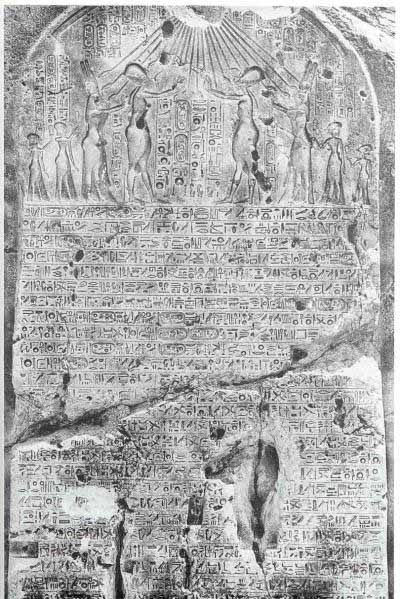
And the Heiress, Swell in the Palace, Fair of Face,
Adorned with the Double Plumes, Mistress of Happiness,
Endowed with Favors, at hearing whose voice the Male monarch rejoices,
the Main Wife of the Male monarch, his beloved, the Lady of the Two Lands,
Neferneferuaten-Nefertiti, May she live for Ever and Always.
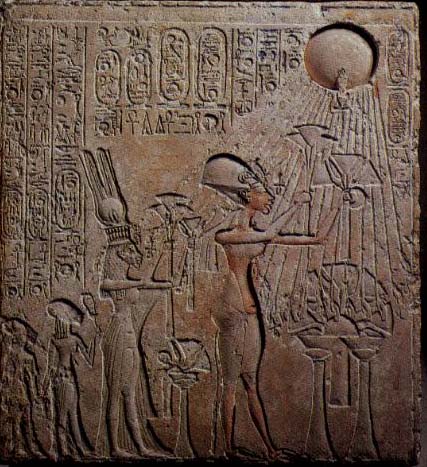
Together Akhenaten and Nefertiti transformed the religious practices of ancient Egyptian society. This limestone relief (higher up), found in the Purple Tomb at Amarna depicts Akhenaten, Nefertiti, and two of their six daughters making an offering to the sun-disk Aten. Akhenaten and Nefertiti acquit flowers to be laid on the tabular array beneath the "life-giving" rays of the Aten.
The figures are carved in the grotesque way, a characteristic of the early on half of the Amarna flow. Nefertiti, sporting the double plumage headdress mentioned in the stela dedication, is the petite figure placed behind her larger calibration husband. The compostion mirrors early artistic representations of the royal couple. To emphasize the force and power of the pharaoh, Egyptian iconographical tradition required the female figure to exist smaller in calibration than the male.
This shrine stela likewise from the early on part of the Amarna period depicts Akhenaten, Nefertiti, and Princesses Meretaten, Mekeaten, and Ankhesenpaaten worshiping the Aten as a family. Dorothea Arnold in her article "Aspects of the Royal Female person Image during the Amarna Menstruum" discusses the plethora of reliefs depicting intimate family moments. While Akhenaten leans forward to requite Meretaten a buss, Mekeaten plays on her mother's lap and gazes up lovingly.
At the same time Ankhesenpaaten, the smallest, sits on Nefertiti's shoulder and fiddles with her earring. Arnold claims that the shrine stela "relates to the Aten religion'southward concept of creation" in which the King and Queen are viewed every bit "a primeval 'first pair." At the top of the composition, the sun-god, Aten, represented by a raised circle, extends his life-giving rays to the Royal Family. The relief uses the concept of the "window of appearances" or a snapshot of life. The figures are framed by a fictive structure which suggests the form of a square window. Aldred in his book Egyptian Fine art calls this "a brief moment in the lives of 5 beings as they are caught in an act of common amore". In actuality, the royal palace at Akhetaten had a window from which the royal couple could find the city and address their subjects.
The names of the daughters were; Meritaten (1349 BC) - Meketaten and Ankhenspaaten (1346 BC) - Neferneferuaten (1339 BC) - Neferneferure and Setepenre (1338).
In 1337 BC the official family, with all half dozen of Nefertiti's daughters was shown for the last fourth dimension.
In 1336 BC Meketaten died in childbirth.
In 1335 Nefertiti seemed to vanish, causeless expressionless.
It is possible that Akhenaten'southward successors Smenkhkare and Tutankhaten were his children by another royal wife called Kiya who became his principle queen for a short while after twelvemonth 12 of his reign.
As with Akhenaten there is no trace of Nefertiti's mummy. Some jewelry begetting her cartouche was constitute outside the purple tomb at Akhetaten but there is no real show that she was cached there. From surviving record it seems she either fell from favor or died at around year 12 of Akhenaten's reign. In this case her burial may have been elsewhere. It is interesting to consider that the busts on this page were establish in a sculptors workshop at Akhetaten. It seems that when the city was abandoned they were left backside because such was the anti Atenist feelings that no ane wanted them.
It is suspected that they were murdered, but the priests of the day who wished to return to the old faith - the worship of a panteon off gods and goddesses - stone idols - things one could see physically.
Nefertiti's place as an icon in popular culture is secure: she has become a celebrity, the second well-nigh famous "Queen" of Egypt in the European imagination and influenced through photographs the changed standards of feminine dazzler of the 20th century.
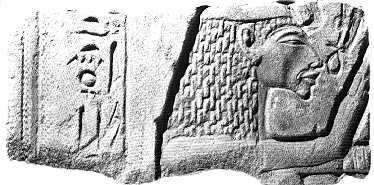
The sandstone relief above institute in a temple at Karnak depicts Nefertiti praying to Aten and is feature of the Karnak way. It shows grotesque features include an oversized ear, a protruding face, an elongated neck and chin. This does remind one of realistic images of Akhenaten, who many suspect suffered from an disease chosen Marfan Syndrome, characterized by unusually long limbs.
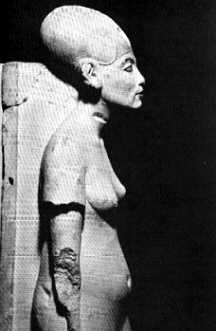
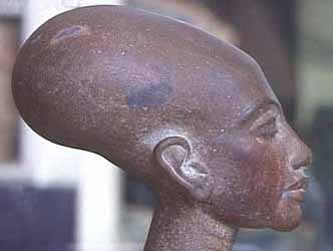
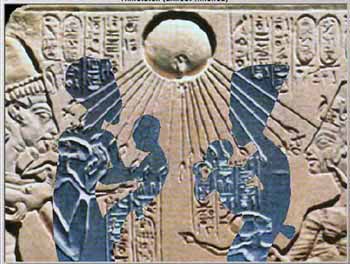
According to Ancient Alien Theory ... Nefertiti and Akhenaten were non of this world ... coming here to help humans understand that there is only one god ... light and consciousness ... and the worship of rock idols is false. Was that really the dominicus they were praying to or something else?
Three thousand years agone, the rebel Pharaoh Akhenaten preached monotheism and enraged the Nile Valley. Less than 100 years after Akhenaten'southward death, Moses would be preaching monotheism on the bank of the Nile River, to the Israelis. The idea of a single God, one time the radical belief of an isolated heretic, is now embraced by Moslems, Christians, and Jews throughout the world. The vision of Akhenaten lives on!
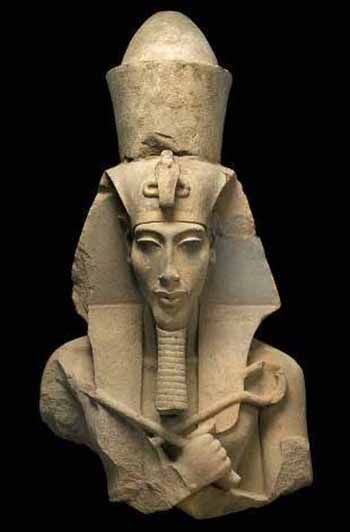
PHARAOH AKHENATEN
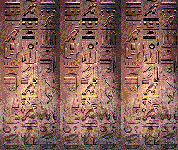
EIGHTEENTH DYNASTY
EGYPTIAN DYNASTIES INDEX
EGYPTIAN PYRAMIDS
Ancient Egypt INDEX
Ancient CIVILIZATIONS Alphabetize
ALPHABETICAL Alphabetize
CRYSTALINKS Habitation PAGE
PSYCHIC READING WITH ELLIE
2012 THE Alchemy OF TIME

villanuevafrompeat1957.blogspot.com
Source: https://www.crystalinks.com/Nefertiti.html
0 Response to "Queen Nefertiti Drawing Full Body"
Postar um comentário